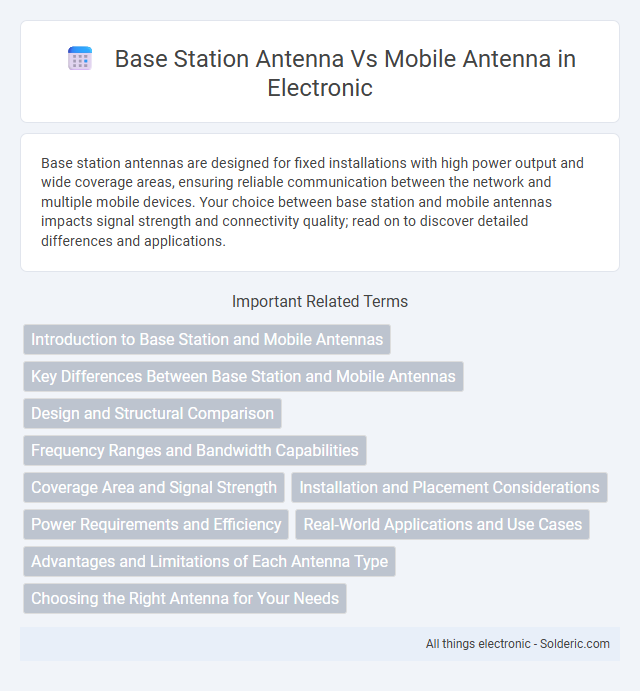Base station antennas are designed for fixed installations with high power output and wide coverage areas, ensuring reliable communication between the network and multiple mobile devices. Your choice between base station and mobile antennas impacts signal strength and connectivity quality; read on to discover detailed differences and applications.
Comparison Table
| Feature | Base Station Antenna | Mobile Antenna |
|---|---|---|
| Purpose | Provides wide-area wireless coverage | Enables mobile device communication |
| Size | Large and fixed installation | Small and portable |
| Power Output | High power, typically tens of watts | Low power, usually milliwatts to a few watts |
| Gain | High gain (10-20 dBi) | Low to medium gain (0-6 dBi) |
| Frequency Bands | Supports multiple bands, often multi-sector | Single or dual band for specific devices |
| Polarization | Usually vertical or dual polarization | Mostly vertical polarization |
| Installation Location | Mounted on towers, rooftops | Integrated into mobile devices, cars |
| Durability | Weather-resistant, rugged | Less rugged, designed for portability |
Introduction to Base Station and Mobile Antennas
Base station antennas are designed for fixed installation, providing wide coverage areas and high gain to support multiple users simultaneously in a cellular network. Mobile antennas, on the other hand, are compact, adaptable devices optimized for individual user equipment, ensuring reliable signal reception and transmission on the move. Understanding the differences in design, range, and application helps you choose the right antenna for network infrastructure or personal use.
Key Differences Between Base Station and Mobile Antennas
Base station antennas typically feature higher gain and directional patterns designed for fixed, long-range communication, while mobile antennas prioritize omnidirectional radiation and compact sizes for mobility and varying environments. Base stations support broader coverage with higher power handling capabilities, whereas mobile antennas optimize for portability and adaptability on vehicles or handheld devices. Your choice between these antennas depends on the application's range, deployment stability, and performance requirements.
Design and Structural Comparison
Base station antennas feature larger, more robust designs optimized for high power transmission and long-range coverage, typically incorporating multiple elements such as dipoles or panels arranged for sectorized broadcasting. Mobile antennas are compact, lightweight, and designed for efficient reception and transmission within limited power constraints, often utilizing flexible materials and simplified structures like monopoles or small whip antennas. The structural differences result from distinct operational roles, with base station antennas prioritizing durability and directional gain, while mobile antennas emphasize portability and omnidirectional capabilities.
Frequency Ranges and Bandwidth Capabilities
Base station antennas typically operate over a wider frequency range, often covering from 700 MHz to 3.8 GHz or higher, supporting multiple bands for cellular networks like 4G and 5G. Mobile antennas are designed for narrower bandwidths, optimized for specific frequency bands such as 700 MHz to 2.7 GHz, ensuring efficient signal reception and transmission for handheld devices. Understanding these frequency ranges and bandwidth capabilities helps you choose the right antenna for enhanced connectivity and network performance.
Coverage Area and Signal Strength
Base station antennas typically offer a wider coverage area and stronger, more stable signal strength compared to mobile antennas, due to their higher placement and optimized design for fixed locations. Mobile antennas are designed for portability and flexibility but generally provide limited coverage and variable signal quality depending on the user's movement and environment. Your choice depends on whether you prioritize broad, consistent coverage or mobility and convenience.
Installation and Placement Considerations
Base station antennas require precise installation on elevated structures such as towers or rooftops to maximize coverage area and minimize signal obstruction, often involving professional alignment tools and strict adherence to safety standards. Mobile antennas, designed for flexible mounting on vehicles or handheld devices, prioritize ease of installation, compact size, and durability to maintain optimal signal reception in dynamic environments. Effective placement for base station antennas focuses on height and line-of-sight clearance to serve large populations, whereas mobile antenna placement emphasizes minimal interference and adaptability to movement.
Power Requirements and Efficiency
Base station antennas typically require higher power output to cover larger geographic areas, ensuring strong and reliable signal transmission over long distances. In contrast, mobile antennas are designed for lower power consumption to maximize battery life and maintain efficiency within smaller, localized environments. Understanding the differences in power requirements and efficiency between these antennas helps optimize Your wireless communication system for performance and energy savings.
Real-World Applications and Use Cases
Base station antennas are crucial in telecommunications infrastructure, enabling wide-area wireless coverage for cellular networks, enhancing signal strength, and supporting high user capacity in urban and rural environments. Mobile antennas, designed for devices like smartphones and vehicles, prioritize compact size and adaptability to maintain connectivity while on the move, ensuring seamless communication and GPS tracking in real-time applications. Your choice between these antennas depends on whether the focus is on network coverage scalability or device mobility and signal reception quality.
Advantages and Limitations of Each Antenna Type
Base station antennas offer higher gain and broader coverage, enabling efficient communication over long distances and supporting multiple users simultaneously, but they are typically fixed and less portable. Mobile antennas provide flexibility and mobility for on-the-go connectivity, adapting to varying environments, though they generally have lower power and range limitations compared to base station antennas. Your choice depends on whether you prioritize stable, high-capacity coverage or flexible, mobile communication.
Choosing the Right Antenna for Your Needs
Choosing the right antenna depends on your specific application, where base station antennas provide higher gain and longer range for fixed installations, while mobile antennas offer portability and flexibility for vehicles or handheld devices. Base station antennas usually support multiple frequency bands and have enhanced durability for outdoor environments, ensuring reliable communication over large areas. Your decision should prioritize coverage requirements, frequency compatibility, and physical mounting constraints to optimize network performance.
base station antenna vs mobile antenna Infographic

 solderic.com
solderic.com